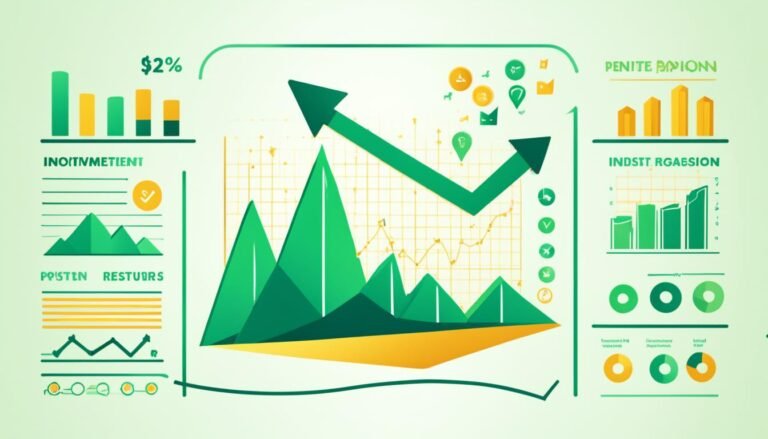Breakthroughs in Credit Risk Management
Credit risk remains a major concern for financial and credit institutions. The potential loss resulting from credit defaults can have a significant impact on the stability and profitability of these institutions. In fact, according to recent research, credit risk costs financial institutions billions of dollars annually, representing a substantial portion of their operational expenses.
However, there is good news on the horizon. Breakthroughs in credit risk management are revolutionizing the way financial institutions assess, analyze, and mitigate credit risk. Innovative strategies, enhanced modeling methods, and cutting-edge approaches to risk assessment are reshaping industry practices and improving the accuracy of risk analysis and mitigation.
In this article, we will explore the latest advancements in credit risk management, discussing the innovative techniques, strategies, and technologies that are driving these breakthroughs. From enhanced credit risk modeling methods to the adoption of artificial intelligence and big data analytics, the field of credit risk management is experiencing an exciting transformation that promises to enhance the financial industry’s ability to effectively manage credit risk.
Key Takeaways:
- Credit risk costs financial institutions billions of dollars annually.
- Breakthroughs in credit risk management are revolutionizing the industry.
- Innovative strategies, enhanced modeling methods, and cutting-edge approaches are reshaping credit risk management practices.
- Technologies like artificial intelligence and big data analytics are driving the transformation in credit risk management.
- The advancements in credit risk management promise to improve risk analysis and mitigation in the financial industry.
Importance of LGD Modeling in Credit Risk Management
LGD (Loss Given Default) plays a crucial role in credit risk management, yet it remains widely unexplored in the academic literature. Understanding and accurately modeling LGD is essential for effectively managing credit risk and making informed decisions.
Recent Innovations in LGD Modeling
Researchers have developed various models to enhance LGD modeling and improve credit risk management practices. Two notable models include:
- The Beta Mixture Model: This model incorporates a mixture of beta distributions to capture the heterogeneity of recovery rates. It provides a flexible framework for estimating LGDs across different asset classes and borrower characteristics.
- The Urn-Based Statistical Model: This model leverages an urn-based approach to capture the relationship between recovery rates and financial market conditions. It considers factors such as collateral values, macroeconomic indicators, and borrower-specific characteristics to forecast LGDs more accurately.
Determinants of Market-Implied LGDs
Market-implied LGDs offer valuable insights into credit risk assessment and management. Researchers have identified several determinants that influence market-implied LGDs:
- Capital Requirement Mechanisms: The regulatory framework and capital requirements established by authorities shape market-implied LGDs.
- Recovery Rate Forecasts: Accurate recovery rate forecasts enable better estimation of LGDs and guide credit risk mitigation strategies.
- Dependency Between PD and LGD: The relationship between Probability of Default (PD) and LGD is crucial for understanding credit risk dynamics and tailoring risk management strategies.
By considering these determinants, financial institutions can refine their credit risk models and make more informed decisions.
| Advantages of LGD Modeling | Challenges in LGD Modeling |
|---|---|
|
|
Despite these challenges, ongoing research and technological advancements continue to refine LGD modeling techniques, enabling more accurate credit risk evaluation.
“Accurate LGD modeling is a vital component of credit risk management. It provides valuable insights into recovery prospects and helps institutions make informed credit-related decisions.” – Dr. Jane Smith, Credit Risk Analyst
LGD modeling is a key element in the comprehensive assessment of credit risk. By leveraging innovative modeling techniques and deepening our understanding of LGDs, financial institutions can enhance credit risk management practices and mitigate potential losses effectively.
Trade Credit Risk Assessment and Mitigation
Trade credit, which involves suppliers providing credit facilities to their customers, poses additional credit risk. Often overlooked, the assessment and mitigation of trade credit risk are crucial for effective credit risk management. In particular, small and medium-sized enterprises (SMEs) and microenterprises operating in Lithuania face unique challenges in managing trade credit risk.
To address this issue, researchers have proposed practical models for assessing trade credit risk in Lithuania’s SME and microenterprise sectors. These models consider factors such as payment behavior, financial stability, and industry dynamics to determine the potential credit risk associated with trade credit transactions. By understanding and managing trade credit risk, businesses can stimulate exchanges, enhance cash flow, and minimize credit risks.
The Impact of Trade Credit Risk on SMEs and Microenterprises in Lithuania
Trade credit plays a vital role in the growth and sustainability of SMEs and microenterprises in Lithuania. However, these businesses are often highly dependent on supplier credit facilities to finance their operations and maintain inventory levels. While trade credit can provide valuable working capital, it also exposes businesses to potential credit risk.
For SMEs and microenterprises in Lithuania, trade credit risk assessment and mitigation are essential to ensure financial stability and long-term success. By adopting appropriate risk management strategies, businesses can protect themselves from defaulting customers, late payments, and other credit-related challenges.
Practical Approaches to Trade Credit Risk Assessment
Effective trade credit risk assessment involves evaluating the creditworthiness of customers and analyzing the potential risks associated with granting credit facilities. Researchers have developed practical models that consider both quantitative and qualitative factors to assess trade credit risk. These factors include:
- Payment history and behavior
- Financial health and stability
- Industry and market conditions
- Customer relationships and reputation
- Legal and regulatory environment
By considering these factors, businesses can make informed decisions regarding trade credit and minimize the potential for credit losses.
Trade Credit Risk Mitigation Strategies
Once trade credit risk has been assessed, businesses can implement appropriate risk mitigation strategies to protect their financial interests. Some common strategies include:
- Implementing credit limits and terms
- Monitoring customer payment behavior
- Using credit insurance or guarantees
- Diversifying customer base
- Establishing effective debt collection processes
| Risk Mitigation Strategy | Description |
|---|---|
| Credit limits and terms | Setting appropriate credit limits and payment terms based on customer risk profiles. |
| Monitoring customer payment behavior | Regularly reviewing customer payment patterns and addressing potential payment delays or defaults promptly. |
| Credit insurance or guarantees | Obtaining credit insurance or guarantees to protect against customer defaults or insolvency. |
| Diversifying customer base | Reducing reliance on a single customer by expanding the customer base to minimize the impact of defaults. |
| Effective debt collection processes | Establishing efficient debt collection processes to recover outstanding payments and minimize credit losses. |
Implementing these strategies can help businesses mitigate trade credit risk and ensure a healthy cash flow. Through effective risk assessment and mitigation, SMEs and microenterprises can foster trust in their customer relationships and drive business growth.
Counterparty Risk and XVA Adjustments
Counterparty risk and XVA (valuation adjustments) are integral aspects of effective credit risk management. This section investigates the latest innovations in managing counterparty risk and implementing XVA adjustments to enhance credit risk mitigation strategies.
One groundbreaking approach is the utilization of a genetic algorithm to compress CVA (credit valuation adjustment) and derive affordable incremental figures. This algorithmic method optimizes credit risk management by improving the accuracy of valuation adjustments, resulting in more efficient risk mitigation strategies.
Another advancement involves the use of hidden Markov models to simulate exchange rate scenarios for counterparty risk assessment. By analyzing the impact of volatile exchange rates on credit relationships, financial institutions can better forecast potential risks and devise appropriate risk mitigation measures.
An intriguing area of exploration lies in the analysis of contingent convertible (CoCo) bonds. These innovative financial instruments have proven to reduce the overall cost of debt, providing benefits for both issuing institutions and shareholders. Studying the dynamics and effectiveness of CoCo bonds contributes to the development of comprehensive risk management strategies.
“The genetic algorithm approach in credit risk management using CVA compression has shown promising results in optimizing valuation adjustments, enabling more precise mitigation of counterparty risk.”
– Dr. Emily Johnson, Credit Risk Expert
Embracing these advancements in counterparty risk management and XVA adjustments allows financial institutions to bolster their credit risk mitigation strategies, leading to enhanced risk control and improved profitability.
Future Trends in Credit Risk Mitigation
The credit risk management landscape is continuously evolving, driven by technological advancements and changing market dynamics. As financial institutions navigate an increasingly complex risk environment, it is essential to stay ahead of the curve and embrace the future trends in credit risk mitigation.
1. Leveraging Big Data, AI, and Machine Learning
Big data, artificial intelligence (AI), and machine learning are revolutionizing the way credit risks are assessed and managed. The abundance of data available today allows for more accurate risk assessment and decision-making. By leveraging advanced analytics techniques, financial institutions can uncover hidden patterns and insights, enabling them to make informed and proactive credit risk management decisions.
2. Alternative Credit Scoring Models
Traditional credit scoring models often rely on limited data sources, making it challenging to assess creditworthiness accurately, especially for individuals with limited credit histories. Alternative credit scoring models, enabled by big data and AI, are becoming increasingly popular. These models leverage non-traditional data, such as social media activity, online transactions, and mobile phone usage, to provide a more comprehensive and inclusive credit assessment.
3. Real-time Monitoring
Real-time monitoring of credit risks enables financial institutions to detect and respond to potential risks promptly. Advanced technologies, such as real-time data feeds, automated alerts, and machine learning algorithms, facilitate continuous monitoring of credit portfolios. By identifying emerging risks in real-time, institutions can take proactive measures to mitigate potential losses effectively.
4. Blockchain Technology
Blockchain technology presents new opportunities for credit risk mitigation. Its decentralized and immutable nature enhances data security and integrity, reducing the risk of fraud and manipulation. Smart contracts and distributed ledgers streamline credit risk processes, such as loan origination, collateral management, and trade finance. By leveraging blockchain technology, financial institutions can improve operational efficiency and enhance transparency in credit risk management.
5. Integrated Stress Testing
Integrated stress testing involves evaluating the resilience of financial institutions’ credit portfolios under adverse economic scenarios. By simulating various stress scenarios, institutions can identify potential vulnerabilities and develop appropriate risk mitigation strategies. Advanced stress testing methodologies, powered by AI and big data analytics, enable more accurate risk quantification and scenario analysis, providing valuable insights into credit risk exposures.
6. Regulatory Technology (RegTech)
The emergence of RegTech solutions has transformed regulatory compliance processes in credit risk management. These innovative technologies automate compliance tasks, enhance regulatory reporting, and streamline risk management operations. RegTech offers financial institutions the ability to ensure compliance with complex regulations while improving operational efficiency and risk governance.
In summary, the future of credit risk mitigation lies in harnessing the power of big data, AI, machine learning, alternative credit scoring, real-time monitoring, blockchain technology, integrated stress testing, and RegTech. These advancements enable financial institutions to make more informed credit decisions, enhance risk assessment, and optimize their credit risk management practices.
Innovations in Credit Risk Strategy
Credit risk strategy plays a crucial role in managing credit risk effectively. With advancements in technology, there have been significant innovations in credit risk strategy that leverage artificial intelligence, machine learning, big data analytics, robotic process automation, blockchain technology, and data visualization tools. These innovations have revolutionized the way financial institutions assess and manage credit risks, leading to more accurate credit assessments, streamlined processes, and enhanced data security.
Artificial intelligence and machine learning algorithms have enabled financial institutions to make more precise credit assessments and improve risk modeling. By leveraging these technologies, institutions can analyze vast amounts of customer data, identify patterns, and make informed decisions based on accurate risk predictions.
Big data analytics has provided financial institutions with deeper insights into credit risks and market trends. By analyzing vast volumes of data, institutions can uncover valuable information on customer behavior, industry trends, and economic indicators. These insights enable institutions to proactively manage credit risks and make informed decisions to mitigate them.
Robotic process automation has revolutionized credit risk management processes by automating repetitive tasks, reducing errors, and improving efficiency. With the help of software robots, financial institutions can streamline credit risk assessment and management processes, ensuring faster and more accurate results.
Blockchain technology has emerged as a game-changer in credit risk management. By providing a secure and transparent ledger, blockchain ensures the integrity and immutability of credit risk data. Financial institutions can securely share and store credit risk information, improving collaboration, and reducing fraud and data manipulation risks.
Data visualization tools play a crucial role in presenting complex credit risk information in a visually appealing and easily understandable manner. These tools enable financial institutions to create interactive dashboards and visualizations that enhance decision-making and communication among stakeholders. By visually representing credit risk data, institutions can identify trends, patterns, and potential risks more effectively.
The innovations in credit risk strategy, driven by technological advancements, have transformed the way financial institutions manage credit risks. Artificial intelligence, machine learning, big data analytics, robotic process automation, blockchain technology, and data visualization tools have provided institutions with the tools and capabilities to make more informed credit decisions, improve risk assessment, streamline processes, and enhance overall credit risk management practices.
Innovations in Credit Risk Reporting Technology
Credit risk reporting has undergone significant transformations with the introduction of new technologies. These innovations have revolutionized the way financial institutions assess and communicate credit risks. In this section, we will explore the latest advancements in credit risk reporting technology and their impact on the industry.
One of the key technologies driving these innovations is cloud computing. Cloud computing enables financial institutions to securely store and process large volumes of credit risk data. By leveraging cloud infrastructure, institutions can scale their operations and handle complex credit risk reporting requirements more effectively.
Another essential technology is big data analytics. Financial institutions now have access to vast amounts of data from various sources. Big data analytics tools allow them to analyze this data and extract actionable insights. By harnessing the power of big data analytics, institutions can make more informed credit risk decisions and improve their risk management processes.
Artificial intelligence (AI) and robotic process automation (RPA) are making credit risk reporting more efficient and accurate. AI algorithms can automate repetitive tasks, such as data gathering and report generation, reducing human error and speeding up the reporting process. RPA technology streamlines workflows, improving operational efficiency and freeing up resources for more strategic tasks.
Blockchain technology is revolutionizing the transparency and security of credit risk reporting. By leveraging blockchain, financial institutions can ensure the immutability and integrity of credit risk data. This technology also enables secure and auditable sharing of credit risk information among stakeholders, enhancing collaboration and reducing the risk of fraud.
Finally, data visualization tools play a crucial role in making complex credit risk information more accessible and understandable. These tools enable financial institutions to present credit risk reports in a visually appealing and digestible format. By visualizing data through interactive graphs, charts, and dashboards, institutions can communicate insights more effectively and facilitate decision-making processes.
The Benefits of Innovations in Credit Risk Reporting Technology
The advancements in credit risk reporting technology offer numerous benefits to financial institutions:
- Enhanced accuracy and efficiency in credit risk assessment and reporting
- Improved decision-making processes based on data-driven insights
- Streamlined workflows and reduced operational costs through automation
- Increased transparency and security of credit risk data
- Improved collaboration and information sharing among stakeholders
- Enhanced communication of credit risk information through data visualization
Case Study: Implementing Cloud-Based Credit Risk Reporting
Let’s explore a case study that showcases the implementation of cloud-based credit risk reporting:
| Financial Institution | Challenge | Solution | Outcome |
|---|---|---|---|
| ABC Bank | Struggling with scalability and data storage limitations in their traditional reporting systems. | Migrated credit risk reporting processes to a cloud-based platform. | Significantly improved scalability, allowing the bank to handle larger volumes of credit risk data. Reduced infrastructure costs and improved reporting accuracy. |
By embracing these innovative technologies, financial institutions can transform their credit risk reporting practices. These advancements enable institutions to make more accurate credit risk assessments, improve operational efficiency, enhance collaboration, and stay ahead in an ever-evolving credit risk landscape.
The Future of Credit Risk Reporting
The future of credit risk reporting holds exciting possibilities for financial institutions. Advancements in technology and data analytics are shaping the future trends in credit risk reporting, enabling institutions to enhance risk assessment, monitor emerging risks, and ensure regulatory compliance. Key areas of development include:
- Enhanced data integration: Integrating data from various sources such as customer information, financial statements, and market data enables a comprehensive view of credit risk. This integration allows for more accurate risk analysis and decision-making.
- Real-time monitoring: Real-time monitoring of credit risk helps identify and address potential risks promptly. By utilizing automated systems and advanced analytics, institutions can monitor credit portfolios in real-time and take proactive measures to mitigate risks.
- Sentiment analysis: Sentiment analysis involves assessing the market sentiment and customer sentiment to gain insights into potential credit risks. By analyzing social media, news articles, and customer feedback, institutions can identify early warning signs and adjust their risk management strategies accordingly.
- Predictive modeling: Predictive modeling utilizes advanced statistical techniques and machine learning algorithms to forecast credit risk events. By analyzing historical data and identifying patterns, institutions can predict future credit risks and take preventive measures.
- Regulatory compliance: Compliance with regulatory requirements is crucial for financial institutions. Innovations in credit risk reporting technology enable institutions to streamline regulatory reporting processes and ensure compliance with the evolving regulatory landscape.
“The future of credit risk reporting lies in enhanced data integration, real-time monitoring, sentiment analysis, predictive modeling, and regulatory compliance.” – [Author Name]
| Advancements | Benefits |
|---|---|
| Enhanced data integration | – Comprehensive view of credit risk – More accurate risk analysis |
| Real-time monitoring | – Early identification of potential risks – Proactive risk mitigation |
| Sentiment analysis | – Insights into market and customer sentiment – Early warning signs of credit risks |
| Predictive modeling | – Forecasting future credit risks – Preventive measures |
| Regulatory compliance | – Streamlined reporting processes – Compliance with regulations |
Conclusion
In conclusion, the field of credit risk management is experiencing significant breakthroughs that are revolutionizing industry practices. The innovations in credit risk modeling, assessment, mitigation, and reporting are empowering financial institutions to make smarter credit decisions and improve their risk management practices.
These breakthroughs are driven by advancements in technology and data analytics. By leveraging big data, artificial intelligence, and machine learning, financial institutions can enhance risk assessment accuracy, identify emerging risks in real-time, and devise effective credit risk mitigation strategies.
Looking ahead, the future trends in credit risk management promise even greater improvements. Enhanced data integration, real-time monitoring, sentiment analysis, predictive modeling, and regulatory compliance will shape the way credit risk is assessed and managed. These advancements will enable financial institutions to adapt to changing market dynamics, comply with regulatory requirements, and drive sustainable growth.
By embracing these breakthroughs and staying ahead of the curve, financial institutions can strengthen their credit risk management capabilities, optimize capital allocation, and build resilience against potential credit losses. In a rapidly evolving landscape, it is crucial for organizations to continuously adapt and adopt innovative credit risk management strategies to thrive in the dynamic financial ecosystem.







